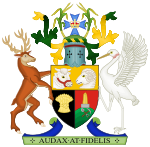Court of Disputed Returns (Queensland)
| Queensland Court of Disputed Returns | |
|---|---|
 |
|
| Established | 1992 |
| Jurisdiction | Queensland, Australia |
| Location | Brisbane |
| Coordinates | 27°28′4″S 153°1′14″E / 27.46778°S 153.02056°ECoordinates: 27°28′4″S 153°1′14″E / 27.46778°S 153.02056°E |
| Composition method | Vice-regal appointment upon nomination by the Premier following the advice of the Attorney-General and Cabinet |
| Authorized by | Queensland Parliament via the Electoral Act 1992 (Qld) |
| Decisions are appealed to | Court of Appeal, Supreme Court of Queensland |
| Judge term length | mandatory retirement by age of 70 |
| Website | www |
| Chief Justice of Queensland | |
| Currently | Catherine Holmes SC |
| Since | 7 September 2015 |
The Queensland Court of Disputed Returns is a court that adjudicates disputes concerning Queensland Government and local government elections and state referendums in Queensland, Australia. The Court is a division of the Supreme Court of Queensland.
A disputed return occurs in which the result of an election is questioned. The name disputed returns derives from the practice in common law countries of the issuing of a writ for the election and then the parliament receiving the results by way of returns after the counting of ballots. The court attempts to eliminate the partisan nature of parliament and gives the determination of electoral disputes to an independent and dispassionate neutral body. As parliament traditionally has the sole authority to determine these matters, parliament must create a special law to bring that body into existence to determine those disputes. Where there is no law, the parliament itself determines these disputes. In the Queensland situation, the parliament has decided that the court should be the only avenue for disputing an election result.
The Court has no jurisdiction in Australian federal elections, where disputed returns are heard in the Federal Court of Australia or, on appeal, in the High Court of Australia.
The Court's jurisdiction over disputed electoral returns can be traced to the practices of the United Kingdom Parliament. There were disputes between the Chancery Court and the House of Commons as to which body had the authority to determine who was rightly elected to Parliament. In 1770, the Grenville Act 1770 (UK) established a form of jury system in which a Select Committee of the House of Commons handled the determination of these disputes. Later, a committee of 11 members was chosen by ballot to report their decision to the House. In 1868, the Parliamentary Elections Act 1868 (UK) was passed conferring jurisdiction on two judges of the Queen's Bench to determine these issues. The transfer of jurisdiction from Parliament to the courts was hastened by a concern with the partisanship of Parliament in ruling on electoral disputes. Essentially, voting along party lines made these disputes an exercise in the numbers rather than a determination on the merits.
...
Wikipedia
